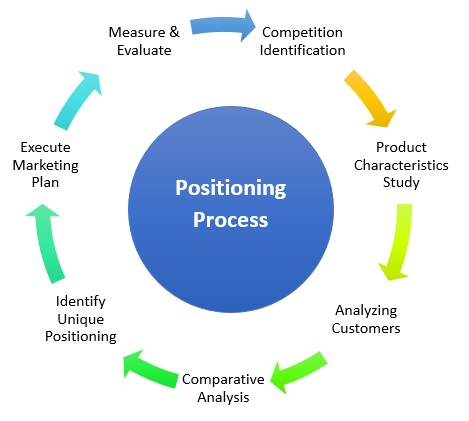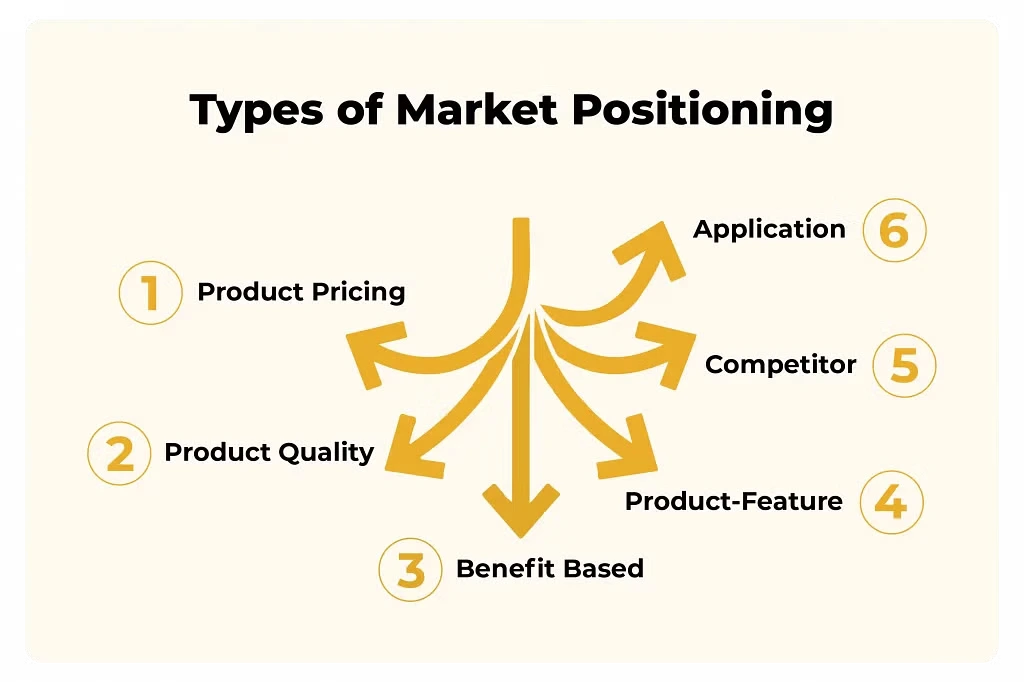The Power of Positioning in Marketing: Types, Benefits & How to Apply It
Table of Contents

In the modern marketplace, filled with countless brands, infinite choices, and highly aware consumers, standing out is not a luxury—it’s a necessity. That’s where positioning in marketing comes into play. Far beyond catchy slogans or sleek designs, positioning in marketing determines how your audience perceives your product, service, or brand about your competitors.
If your brand doesn’t have a clearly defined market positioning strategy, you risk blending into the background, no matter how good your product or service is. This article explores the types, benefits, and applications of positioning in marketing while also diving deep into how it connects with brand positioning, segmentation, targeting, and positioning, and the long-term goals of building a unique presence in consumers’ minds.

*mbaskool.com
What is Positioning in Marketing?
At its core, positioning in marketing refers to the process of creating a distinct image and identity for a brand, product, or service in the minds of the target audience. It’s about answering the consumer’s question: “Why should I choose you over others?”
Effective positioning in marketing means strategically shaping perception. It involves highlighting specific qualities, benefits, or emotional associations that set your brand apart. It’s what makes Apple “innovative,” Volvo “safe,” and Nike “empowering.”
This strategic perception is not built by accident; it’s created through deliberate messaging, product design, pricing, packaging, customer experience, and communications—all aligned to make a brand occupy a unique space in the market.
The Link Between Positioning, Brand Identity, and Customer Loyalty
A solid market positioning strategy doesn’t just attract customers—it creates loyal ones. When customers relate to a brand’s values or identity, they are more likely to choose that brand repeatedly. That’s the power of effective brand positioning: it connects rational benefits with emotional relevance.
For example, if a brand positions itself as “sustainable” and backs it up with eco-friendly practices, recyclable packaging, and honest storytelling, it not only attracts conscious consumers but also wins long-term advocates.
Therefore, positioning in marketing isn’t just about selling; it’s about belonging, identity, and trust.
Segmentation Targeting and Positioning: The Strategic Trio
Before applying any market positioning strategy, marketers must first understand who they are targeting. This is where Segmentation Targeting and Positioning (STP) comes in—a powerful framework that ensures the message reaches the right audience in the right way.
Segmentation
This involves dividing the market into distinct groups based on demographics, psychographics, behaviour, needs, or geographic location.
Targeting
Once the market is segmented, businesses identify which segment(s) are most viable or profitable to focus on.
Positioning
Now, the message and brand perception are crafted specifically for that chosen segment, ensuring maximum relevance and appeal.
Without segmentation targeting and positioning, your marketing efforts are likely to be scattered and inefficient. The STP model ensures that positioning in marketing is precise, powerful, and personalised.

*codilar.com
Types of Positioning in Marketing
Understanding the different forms of positioning in marketing allows brands to choose the most effective route to stand out. Let’s explore the main types:
Product-Based Positioning
Here, the focus is on the product’s features or benefits. Think of a phone marketed for its camera quality or a laptop for its processing power.
Price-Based Positioning
Brands that offer value for money, discounts, or premium pricing use this approach. Examples include budget airlines or luxury fashion labels.
Quality-Based Positioning
This type emphasises superior craftsmanship, reliability, or performance. It is common in the automobile, appliance, or electronics sectors.
Use or Application-Based Positioning
Brands position themselves based on how or when the product is used—e.g., energy drinks for athletes or night creams for overnight skincare.
User-Based Positioning
Here, the brand targets a specific type of user, such as “young professionals,” “working mothers,” or “millennials.”
Competitor-Based Positioning
This involves directly comparing a brand against competitors. It’s a bold form of positioning in marketing that must be backed with clear advantages.
Emotional Positioning
Rather than focusing on logic, this type appeals to feelings, like joy, safety, pride, or aspiration. It’s frequently used in branding campaigns to build deep emotional resonance.
Each of these approaches plays a crucial role in shaping a comprehensive market positioning strategy that aligns with business goals, audience expectations, and market trends.
Benefits of Strong Brand Positioning
When a business masters brand positioning, it gains more than just visibility. Here are some key benefits:
Clarity in Messaging
A well-positioned brand communicates its value clearly, reducing confusion and increasing conversion rates.
Competitive Edge
In saturated markets, unique positioning in marketing is what makes a brand memorable and desirable.
Customer Loyalty
Brands with strong brand positioning become emotionally resonant, leading to repeat purchases and word-of-mouth advocacy.
Higher Profit Margins
Premium positioning in marketing allows brands to charge more by adding perceived value.
Strategic Consistency
A defined market positioning strategy acts as a guide for all branding, marketing, and communication activities.
Bridging Marketing with Performance
In today’s fast-evolving digital economy, marketing is no longer just about creativity—it’s about performance. Professionals seeking to build or refine their market positioning strategy must now integrate data, digital tools, and performance metrics into their approach.
That’s why advanced programs like the Professional Certificate Programme in Digital Marketing for Performance & Growth – IIM Kozhikode are gaining popularity. It empowers marketing professionals to apply insights-driven strategies, refine audience targeting, and optimise positioning for maximum impact—all while staying relevant in the digital-first business landscape.
The future of positioning in marketing lies at the intersection of strategy and performance. Knowing how to connect brand value with measurable outcomes is no longer optional—it’s essential.
How to Apply Positioning in Marketing: A Step-by-Step Approach
Understanding positioning in marketing is one thing—applying it effectively is another. Many brands struggle not because their product lacks quality, but because they fail to position it in a way that resonates with their audience.
Here’s a practical framework for applying a winning market positioning strategy:
Step 1: Conduct a Positioning Audit
Before crafting your positioning, evaluate where your brand currently stands. Use surveys, focus groups, customer feedback, and competitive analysis to understand how your audience perceives you and your competitors.
Ask:
- What do people currently associate with our brand?
- Who do they think we serve?
- How do we compare to competitors?
This step sets the groundwork for a future-ready brand positioning approach.
Step 2: Define Your Ideal Customer
No segmentation targeting and positioning effort can be effective without clarity on who your ideal customer is. Go beyond basic demographics. Consider:
- Lifestyle
- Pain points
- Aspirations
- Buying behaviour
- Brand preferences
By understanding these, you can develop a market positioning strategy that speaks directly to your most valuable segments.
Step 3: Analyse Your Competitors
Understanding your competitive landscape is essential in shaping strong brand positioning. Identify:
- What are your competitors claiming?
- What space are they occupying in the market?
- Where are the gaps in their messaging or product offerings?
These gaps are opportunities for unique positioning in marketing spaces your brand can claim.
Step 4: Identify Your Unique Value Proposition (UVP)
This is the most critical element in any market positioning strategy. Your UVP is the one thing that differentiates you. It should be:
- Clear
- Specific
- Valuable to the customer
- Difficult for competitors to replicate
Whether it’s customer service, speed, personalisation, price, or innovation, your UVP becomes the anchor for all brand positioning efforts.
Step 5: Craft a Positioning Statement
Your positioning statement helps internal teams maintain consistency. It should answer:
- Who are you for?
- What do you offer?
- Why is it valuable?
- How is it different?
A good positioning statement is not a tagline, but it informs your tagline, messaging, content, and advertising tone. It’s the strategic backbone of your positioning in marketing.
Step 6: Align Your Marketing Mix
Once your market positioning strategy is defined, align all aspects of the marketing mix (Product, Price, Place, Promotion) to reinforce it.
For example:
- A premium brand positioning must reflect premium pricing and packaging.
- A brand positioned as accessible must have a strong distribution presence and affordable pricing.
- A tech-savvy brand should deliver modern UX and digital-first engagement.
Consistency between positioning and execution builds trust and clarity.
Step 7: Monitor, Measure, and Adapt
Positioning is not a one-time activity. As markets evolve, so must your brand positioning. Use Key Performance Indicators (KPIs) such as:
- Customer sentiment
- Net Promoter Score (NPS)
- Brand recall and awareness
- Conversion rates
These metrics offer insights into how well your positioning in marketing is working and where refinement is needed.
Real-World Examples of Effective Brand Positioning
Let’s look at a few iconic brands and how their market positioning strategy has contributed to their success:
Tesla – Innovation & Sustainability
Tesla doesn’t just sell electric cars—it positions itself as a symbol of forward-thinking technology and environmental responsibility. This emotional and functional positioning elevates its value far beyond vehicles.
Airbnb – Belonging Anywhere
Rather than focusing on accommodation, Airbnb’s brand positioning emphasises experiences and connection, creating a deep emotional bond with its users.
Apple – Simplicity Meets Innovation
Apple’s positioning in marketing revolves around elegance, simplicity, and breakthrough innovation. Its consistent messaging across all touchpoints has made it one of the most recognisable brands globally.
These examples prove that clear and consistent brand positioning fosters consumer loyalty and market dominance.
Challenges in Positioning in Marketing and How to Overcome Them
Even the best market positioning strategy can face obstacles. Here are common challenges and ways to overcome them:
Market Saturation
In crowded markets, it’s hard to stand out. Focus on emotional positioning or community-driven branding to cut through the noise.
Inconsistent Messaging
Inconsistency kills clarity. Develop a positioning guidebook and align all departments—marketing, sales, product—on a unified message.
Evolving Consumer Expectations
Stay close to your audience. Conduct regular market research and use agile strategies to refine your segmentation targeting and positioning.
Copycat Competitors
If your position is being mimicked, double down on what only you can offer—whether it’s your brand story, customer experience, or exclusive partnerships.
Remember, strong positioning in marketing is both proactive and responsive.
Final Thoughts
In 2025 and beyond, the brands that will dominate are those with a clear, consistent, and compelling market positioning strategy. It’s not just about visibility—it’s about meaning. When customers understand and connect with your brand’s position, they become more than buyers; they become advocates.
Positioning in marketing is no longer optional—it’s foundational. It influences every marketing decision, from creative direction to campaign execution and long-term strategy.
Whether you’re building a new brand or repositioning an existing one, remember: clarity wins. Emotion connects. Consistency retains.
If you’re a marketing or sales professional looking to master the art of high-performance branding and measurable strategy, consider the Professional Certificate Programme in Digital Marketing for Performance & Growth – IIM Kozhikode. Facilitated through Jaro Education, this program is designed to help you apply real-world marketing principles—including segmentation, targeting, and positioning, performance analytics, and growth strategy—across any industry. Elevate your skills, build brand equity, and become the strategist companies want on their team.
Frequently Asked Questions
Can small businesses benefit from positioning in marketing?
Absolutely, positioning in marketing helps small businesses stand out by highlighting their unique strengths, values, or local connections. Even with limited budgets, a strong brand message can build loyal customers and outperform larger competitors.
How long does it take to see results from a market positioning strategy?
The impact of a market positioning strategy can vary. While initial clarity and engagement may be visible within months, building long-term brand equity typically takes 6–18 months, depending on consistency and audience reach.
Is emotional branding more effective than product-based positioning?
Emotional brand positioning often creates deeper customer loyalty, especially in crowded markets. However, its effectiveness depends on the target audience and product type. High-involvement purchases may benefit from a blend of both emotional and functional positioning.
Can a company change its positioning later?
Yes, but repositioning requires careful planning. Businesses may need to revisit their segmentation targeting and positioning strategy, update messaging, and reintroduce their value to both existing and new customers.
How does digital marketing support positioning in marketing?
Digital tools help refine and amplify positioning in marketing through targeted messaging, measurable performance, audience segmentation, and multichannel consistency. Analytics also make it easier to adjust strategy in real time.


















